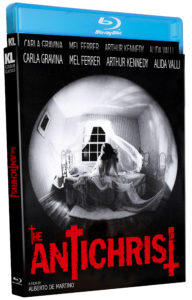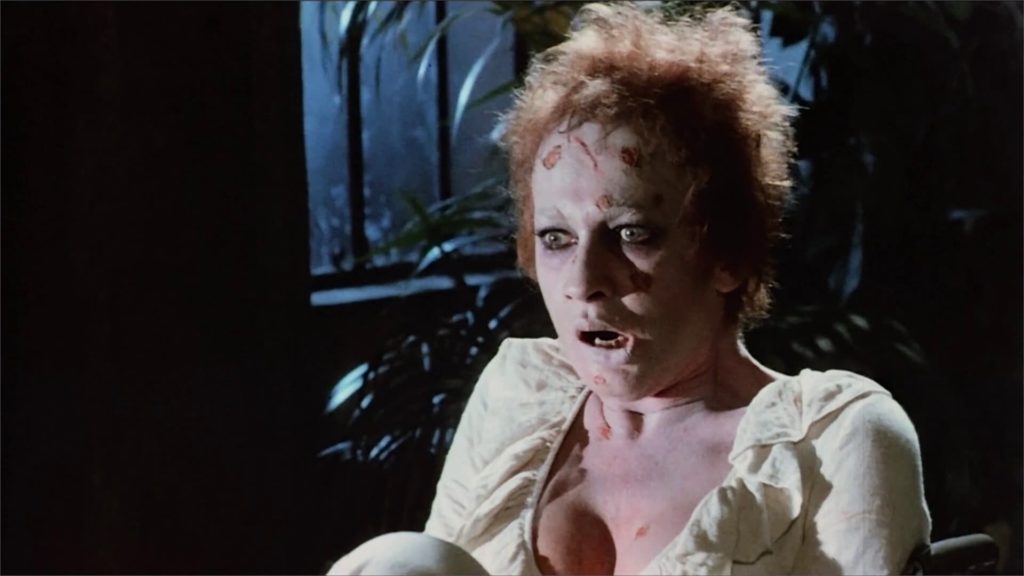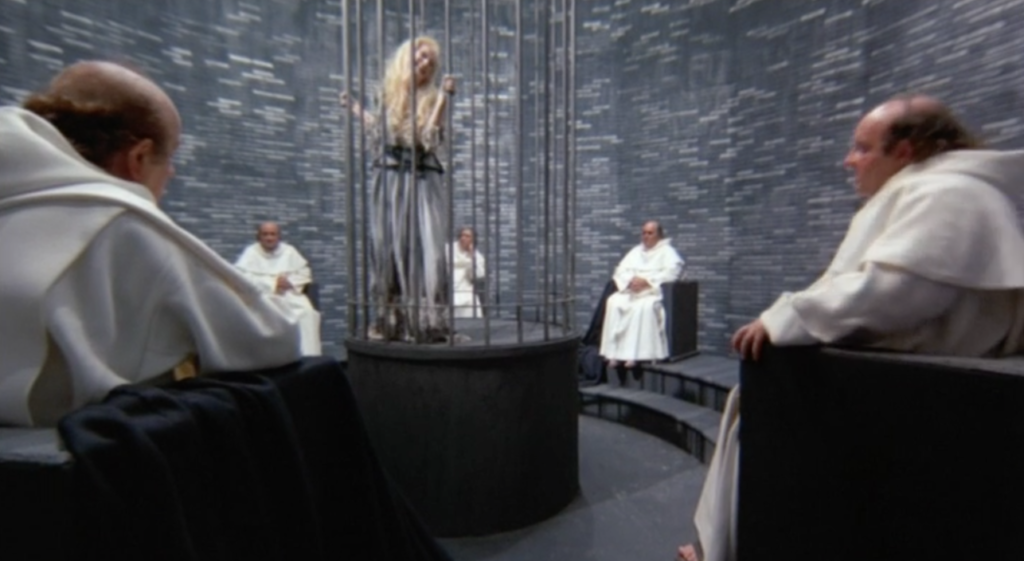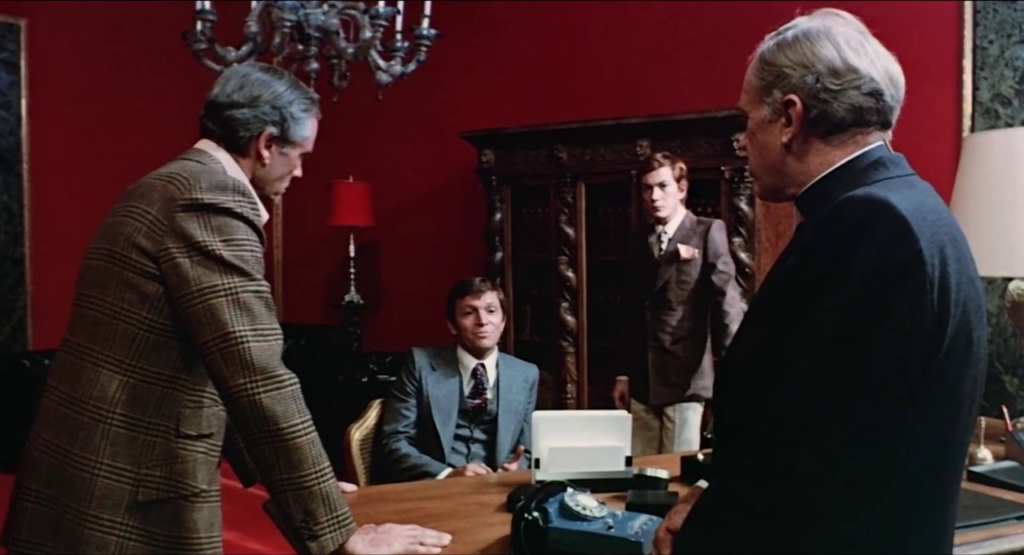One Devil of an Exorcist Rip-off
DIRECTED BY Alberto De Martino/ITALIAN/1974
BLU-RAY STREET DATE: FEBRUARY 8, 2022/KL STUDIO CLASSICS

“In your opinion, does The Devil exist?”
”There’s no doubt about it.”
Born in the popular shadow of The Exorcist but also borrowing a good bit of Rosemary’s Baby, director Alberto De Martino’s 1974 spiritual horror feature The Antichrist (L’anticristo; aka The Tempter) rises to the occasion better than most devil-movie knockoffs of the time.
Eerie religiosity and the eventual battle to cast out an evil spirit are absolutely the main course, though unlike its loftier American inspirations, The Antichrist also owes something to the garish process effects of Bert I. Gordon (Village of the Giants). When the film’s possessed heroine telekinetically hurls a heavy piece of furniture at someone, the piece of furniture becomes a flat picture of itself that grows larger as it supposedly approaches. When the poor overtaken woman floats, it’s suddenly a discolored cutout of her “floating” with her fellow actors reacting to nothing. For these wanting results, De Martino in a later interview recalls that he had to fight a war to get her to float like that.
The Devil really is in these details. It’s The Antichrist’s leaning on these awful visual effects that take a lot of the piss out of the thing. The otherwise terrifically acted and scary movie gives way to such laughable crudity. While it’s generally not fair to mock an older film for employing visual effects that haven’t aged well, this must fall into a different category. Did these effects ever look convincing to anyone?? Anyhow, the over-reliance on these matte effects is by far the film’s weakest link.

Carla Gravina (Alfredo, Alfredo) goes all out in the lead role of the anguished Ippolita, confined to a wheelchair and reeling with terrifying memories of her witching actions from another lifetime. As the film unspools, she mentally leans in more and more to this dark persona. By the final act, she will be fully taken over by it. You can tell just by looking at her. Her short Carol Burnett hair stands on end. Her frightened eyes go assuredly demonic. Holy water burns bloody pockmarks onto her greying skin. She wants to kill everyone, which she did not want to do before. Gravina truly gives it her all, selling every aspect of her murkily written character’s shift from timid helplessness to predatory cougar (easily picking up a teenage boy on the street for her lusty purposes) to gleefully demon-voiced demented monster woman. The Antichrist rests fully on her shoulders, and she carries it better than it sometimes deserves.
Although The Antichrist seems to be attempting a Mia Farrow Rosemary’s Baby arc and hairstyle (unsuccessfully) for Ippolita, then following that up with a full-blown windy and theatrical exorcism complete with the spitting of pea soup, it also goes all in on its Italian locale and DNA. Even as scenes of centuries-ago Catholic rites and perpetual contemporary reverence for the deeply Biblically inspired classic Italian art of the Renaissance pile up. That and the fine marbled walls of the vast aristocratic home where much of the story occurs, as well as the ancient ruins at the very end… De Martino truly seems all about flaunting the film’s nationality in an undeniably baked-in way. Too bad he’s depicting Italy as a centuries-long major Satanic hub.

Unlike The Exorcist and Rosemary’s Baby, The Antichrist pushes harder into adult territory. Ippolita’s burgeoning lust manifesting is presented in connection with flashbacks of naked paganism from centuries prior. For her intimate involvement with a literal horned devil man (The Devil himself?), her past self will be caged, tortured, and tried by robed men of the cloth. In contemporary 1974, Ippolita reacts unapprovingly to her father’s (Mel Ferrer) trysts with an attractive younger woman (Anita Strindberg) by terrifying him and her strange brother with her own heated displays. In her otherwise modest white dress, she throws her feet up onto the table, spread far apart. In this moment, Ippolita is foaming at the mouth while cackling like a deranged hyena woman. The out-of-nowhere surge of winds from outside blowing the curtains madly give proof to her supernatural condition. The Italian religious masterpieces on the wall begin to float erratically in a threatening manner. The wheelchair is no longer needed. No one knows what the heck to do.
Although The Antichrist nowadays finds itself relegated to the ghetto of “cult curio”, that designation carries some of its strongest allure in the increasingly niche world of Blu-ray collecting. Look no further than the inclusion of a coveted cardboard slipcover packaging, an inclusion that never fails to be catnip to many an enthusiast. Which is fine; these things look great on the shelf.
The 1080p transfer of StudioCanal’s new 4K restoration also looks pretty great. While nothing can salvage the silly effects shots, everything else radiates the kind of ominous intense elegance that De Martino and cinematographer Aristide Massaccesi (who would later become the infamous hardcore movie director Joe D’Amato) were truly after. The disc also does a fine job with the film’s maniacal soundtrack, including music by maestros Ennio Morricone (The Good, the Bad and the Ugly) and Bruno Nicolai (A Full Day’s Work). The film can be viewed with either its dubbed English track, or its Italian 2.0 audio track. English subtitles are optional. Of the two, the Italian track with subs felt like the more natural option.

This KL Studio Classics special edition ports over a decent Blue Underground/Anchor Bay DVD-era bonus featurette Raising Hell, with De Martino and legendary composer Ennio Morricone. There’s also a TV spot for the film’s release as “The Tempter”, and a very low-quality (in standard definition) clip of that version’s opening titles. Finally, there’s a new audio commentary by author/film historian Lee Gambin and film critic Sally Christie. Gambin and Christie are pros at this and have a particularly great repartee together. The track stays on-point even while going in many apt directions. These were the right people for this job.
Whatever one’s personal views are on the existence of The Devil, there was no doubt about his impact on movies in the early 1970s. While the execution of The Antichrist’s more fantastical aspects leaves much to be desired, there’s no denying the positives in this oblique and sometimes wild horror programmer. In short, this encounter with The Devil and all his works mostly works.

